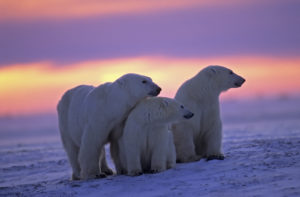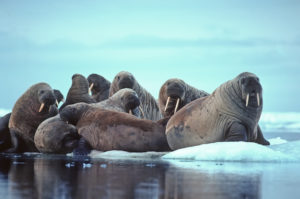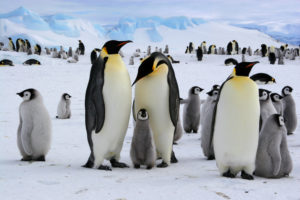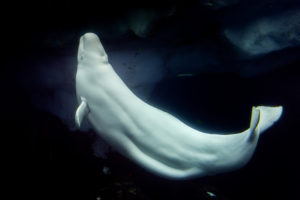Often referred to as global warming, climate change is caused by a combination of natural and human influences. Human factors that affect climate change include deforestation, animal agriculture, ozone depletion and the massive increase in fossil-fuel consumption since the Industrial Revolution. When we burn fossil fuels, including coal, oil and natural gas, we release greenhouse gases into the atmosphere. These gases accumulate, trapping heat from the Earth’s surface and creating a significant increase in global air and sea temperatures. The effects of global warming are visible everywhere, but perhaps nowhere more so than in the Arctic and Antarctica. Polar climate change affects habitat for countless species that cannot survive elsewhere.
The most obvious impact of polar climate change is the large-scale ice melt as a consequence of rising sea temperatures. In the Arctic, when ancient permafrost thaws, it releases carbon and methane gases that have been trapped beneath the ice for millions of years. These gases add to the greenhouse effect, causing further warming and melting, and so the cycle continues. Similarly, while ice and snow reflect approximately 90 percent of the sun’s energy, open water absorbs approximately 94 percent of it. Therefore, as the ice melts and exposes more water, the polar environment absorbs more heat.
The entire ecosystem at both poles relies on the continued presence of sea ice. Polar animals, depending on the species, use the sea ice as nesting sites, a resting place or a breeding ground. Most importantly, the polar food chain is built upon the sea ice. Sea algae adheres to the underbelly of the ice, providing food for krill. This in turn provides sustenance either directly or indirectly to the entire spectrum of polar wildlife. Without ice, life in the Arctic or Antarctica would be impossible. This why climate change has the potential to wreak such devastation in these fragile regions. Here we’ll take a look at five of the marine species most threatened by polar climate change and melting ice.
 Polar Bear
Polar Bear
Conservationists often depict polar bears as the poster species for climate change in the Arctic, and for good reason. In 2014, a study carried out on polar bears in northeast Alaska and the Northwest Territories documented a 40 percent population loss between 2001 and 2010. These figures represent this species’ decline throughout its range as a direct result of disappearing sea ice. According to experts, Arctic sea ice is melting at a rate of 9 percent per decade. This puts the polar bear’s exclusive habitat in danger.
Polar bears depend on the ice as a hunting ground and as a vital resting place. The bears prey mainly on seals. They ambush the seals as they sleep on ice floes or surface through holes in the ice to breathe. The disappearance of the sea ice means that polar bears have to swim greater distances to find the seals. In 2008, the U.S. Endangered Species Act listed the polar bear as a threatened species.
 Walrus
Walrus
Walrus populations in the Arctic are also at risk due to imminent habitat loss. Walruses spend approximately half their life on the ice, which they use as a resting place, and as a breeding and pupping ground. Traditionally, female walruses and their calves spend the summer on the fringes of the Arctic sea ice. But in 2014, the drastic shrinking of the summer ice fields forced 35,000 walruses to haul out at Point Lay beach in Alaska instead.
On land, walruses aggregate in one spot instead of spreading out as they would on ice. The slightest disturbance can cause a stampede, in which the newborn calves are often crushed and killed. Disease spreads quickly and the accumulated filth of the impromptu walrus colony ensures that any injuries rapidly become infected. With scientists anticipating that summer sea ice could disappear completely in the near future, the horrors of the 2014 mass haul-out at Point Lay may soon become commonplace.
Greenland Shark
The Greenland shark is one of only two shark species that live in Arctic waters. Relatively little is known about this enigmatic species thanks largely to its preference for deep water. However, we do know that the Greenland shark is a predator at the top of the complex Arctic food web. If the sea ice disappears, the algae that forms the basis of that food web will also disappear, causing a collapse that will affect all species, including the Greenland shark. Another potential hazard of climate change in the Arctic is the expansion of commercial fisheries as the melting ice makes the region more accessible.
Greenland sharks have toxic flesh, so fisheries do not target them. However, because they live predominantly on the seafloor, they are susceptible to bycatch as a result of benthic trawling methods. Greenland sharks mature at a late age and have a slow rate of reproduction, making it unlikely that they could recover should overfishing become a problem.
 Emperor Penguin
Emperor Penguin
In 2014, a group of researchers published a study based on an emperor penguin colony at Terra Adelie in Antarctica. The study stated that by the end of the century, more than two-thirds of Antarctica’s emperor penguin colonies will have declined by at least 50 percent if climate change continues at its current rate.
Like most polar species, changes to the sea ice are triggering this decline. The ice provides crucial habitat for the emperor penguins as a breeding and nesting site. In Antarctica, shifting weather patterns have resulted in the decline of ice in some areas, and an increase of ice in other areas, both of which adversely affect the penguin colonies. If there is too much ice between their nesting site and the sea, adult penguins have to travel further to hunt and bring back food for their chicks. If there is not enough ice, the penguins risk losing their nesting sites as well as a reduction in the abundance of krill, a critical food source for this species.
 Belugas
Belugas
The imminent collapse of the food chain as a result of disappearing sea ice threatens beluga whales as well. As Arctic waters become increasingly navigable, fisheries and oil and gas prospectors will flock to the region. This means an exponential rise in shipping traffic. This causes a problem for belugas (and all Arctic whales), as the ships’ sonar interferes with their echolocation techniques. The melting sea ice also means that the belugas can’t use camouflage as a defense mechanism against predation.
Perhaps most seriously for the belugas, rising Arctic sea temperatures have caused the proliferation of one such predator, the killer whale. Unpredictable weather patterns associated with climate change often cause pack ice to rapidly shift and refreeze, as well, trapping the belugas underneath. The whales then congregate around small holes in the ice to breathe, where they become easy pickings for their other major predator, the polar bear.
These five species represent just a tiny fraction of the total biodiversity threatened by polar climate change. Sometimes, the sheer scale of this destruction seems overwhelming. It’s easy to feel that losing the Arctic and Antarctic ecosystems is a foregone conclusion. But all is not lost. Although the Arctic ice sheet has undoubtedly diminished over the last 10 years, measurements of the ice sheet at its minimum summer extent in 2014 showed an improvement of approximately 580,000 square miles on the same measurements for 2012.
We can still win the fight to save the polar regions, and you needn’t be a scientist to help. Human activity is largely to blame for climate change, so take charge of your choices and reduce your footprint. Turn off the lights when you leave a room. Stop eating meat and fish, or at least drastically curtail your consumption. Walk or bike short distances instead of driving. These actions may seem small, but if we all committed to them, the cumulative benefits for not only the polar ice, but for the entire planet, would be huge.





